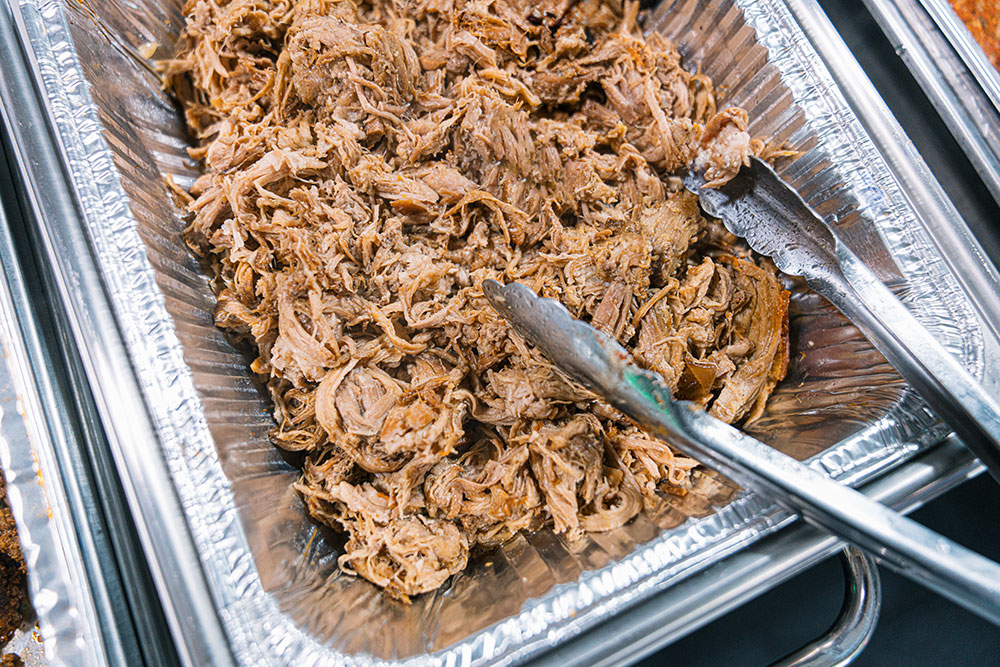
Who doesn't love a party with friends, family, and tasty food? Some people host outdoor gatherings and pig roasts in their backyard; but pig roasts have been a source of foodborne outbreaks. Para mantener segura la comida asada de cerdo, es importante tomarse el tiempo para planificar y preparar adecuadamente.
When purchasing a pig:
- You can purchase a live pig and have it processed by an inspected facility or custom operator. Live pigs can be purchased from local farmers or arranged with the help of an inspected or custom operator. Whole pig carcasses can be purchased from inspected facilities or retail meat markets and grocery stores that offer them for sale. You may need to ask and allow for sufficient time for them to make arrangements.
- Have the supplier wrap the pig in food-grade plastic to protect the pig from the environment (dust, dirt, etc.) and prevent the juices from spreading harmful bacteria.
- Many whole pigs are too large to fit in a refrigerator. If it won't fit, pick up the pig the day of the roasting right before the event and keep chilled using other methods.
- Keep the pig cold by placing it in the refrigerator or nestled under ice in a large cooler or container. This will keep the meat from entering the Danger Zone, between 40 degrees F and 140 degrees F, where harmful bacteria multiply rapidly and could get you sick.
How to thaw a pig safely:
- Frozen pigs, depending on their size, will need several days to thaw before cooking.
- A whole pig can be thawed in a refrigerator or nestled under ice in a large cooler or container. Check to confirm the ice cubes do not melt - this means it is below a safe temperature, i.e., below 40 degrees F. Replenish ice as needed. Clean and sanitize the cooler or container before and after thawing.
- If you don’t have a safe way to thaw the pig, plan to pick up a thawed pig right before the event or have the place of purchase store it until ready for pickup.
Follow the four food safety steps:
- Clean: Anything that comes into contact with the raw whole pig should be washed with hot soapy water afterward (hands, utensils and surfaces).
- Separate: Juices from the raw pig contain harmful bacteria that can make you sick. Keep the raw pig separate from your ready-to-eat food to avoid cross-contamination.
- Cook: FSIS recommends that pork products be cooked to a minimum internal temperature of 145 degrees F with a 3-minute rest time. Check the internal temperature with a food thermometer in several places. Serve the meat you carve within 1-2 hours.
- Chill: Once cooked, remove remaining portions from the cooked pig, pack them into shallow containers, and refrigerate within 2 hours or 1 hour if the temperature is above 90 degrees F.
Have questions?
Talk to a food safety specialist and get answers to your questions about food safety.
- For non-meat food products (cereals, fish, produce, fruit juice, pastas, cheeses, etc.): Contact the U.S. Food and Drug Administration, Center for Food Safety and Applied Nutrition’s Food and Cosmetic Information Center at 1-888-SAFEFOOD (toll free), Monday through Friday 10 AM to 4 PM ET (except Thursdays from 12:30 PM to 1:30 PM ET and Federal holidays).
- For meat, poultry and egg products, contact the USDA Meat and Poultry Hotline at 1-888-MPHotline (1-888-674-6854) email MPHotline@usda.gov, or chat live at ask.usda.gov from 10 a.m. to 6 p.m. Eastern Time, Monday through Friday in English and Spanish.

